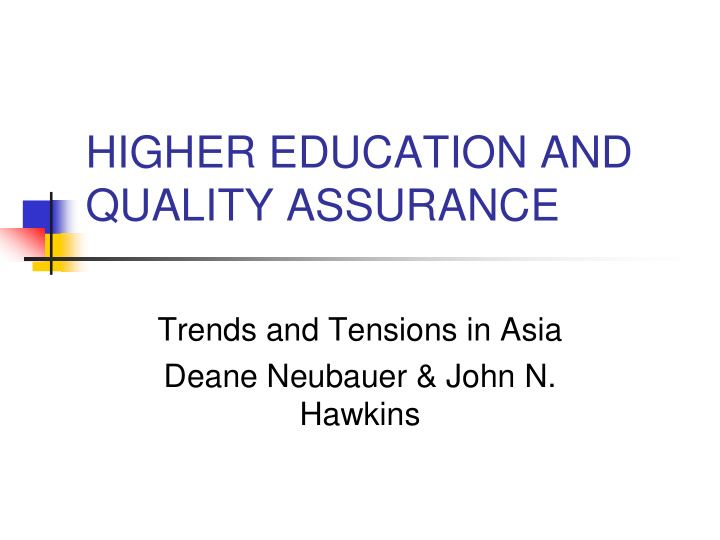



HIGHER EDUCATION AND QUALITY ASSURANCE Trends and Tensions in Asia Deane Neubauer & John N. Hawkins
High Level of Interest in QA � Conferences in Region � Associations of Universities of Asia and the Pacific 2006: “Towards and Asia-Pacific Quality Assurance and Accreditation in Higher Education” 200+ attendees � OECD 2006: “Higher Education Quality, Equity and Efficiency” � UNESCO Paris � The Street (China, France, India)
Some Fundamental Contradictions � Context of “decentralization” in HE, but centralization in QA? � QA greeted both with enthusiasm and cynicism? � Broad political-economic forces and factors: neo-liberalism, managerialism, corporatization
Why QA? Why Now? � Massification + increased diversity = demand for more information among stakeholders � HEIs can use it for branding purposes � Governments can use it for increased control and leverage
Some Basic Shifts � From “bottom up” to an increase in external influences � Shift on continuum of control from less to more � Emphasis on accountability rather than performance? � HE governance shift from collegial to managerial; QM seeks to spread the message � Evaluative culture is here for better or worse
Factors, Forces & Rationales HE more diverse, more available, more international, less � money to go around, private sector has expanded, changing governance patterns=more competition Accountability for public funding in context of withdrawal of � central support Need for better information to make funding decisions w/in HEIs � Improve quality of performance � Inform stakeholders (parents, students, etc.) � League tables, rankings � Rise of private sector �
Search for a General Model of QA � National coordinating body (links to MOE) � Institutional self evaluation � External evaluation by peers � Published reports � Follow-up � Levels: system, institutional, basic unit, individual � Mechanisms: rewards, changing policies or structures, changing HE cultures
Reward Mechanisms � Should QA be linked to funding? � Region-wide concern with status- allocation, accreditation � League tables, rankings (goal to get in the top 100) � Much disagreement on methodology, who should conduct rankings, etc.
Policy and Structure Change � Incremental change (w/in institution) v. fundamental change (external)--Clark � Latter can result in mergers or termination of units � Does policy change really matter? HEI entrenched interests very good at subverting policy directives � Difficult to determine what cause what
The Culture of HEIs � HE culture naturally opposes change � Clark’s notion of the “happy anarchy” � QA is meant to change all of that � QA seeks to change boundaries, realign landscape between HEIs and state and stakeholders � Strengthen one factor over another � Replace tribal culture with system-wide accountability measures
Formal QA a Relatively New Phenomenon � Two-thirds of QA systems in A/P region have been established in last decade � From simple to complex processes � Multiple definitions; INQAAHE offers one: “. . .quality assurance may be related to a program, an institution or a whole higher education system. In each case, QA is all of those attitudes, objects, actions, and procedures which through their existence and use, and together with the quality control activities , ensure that appropriate academic standards are being maintained and enhanced in and by each program.” Antony 2006 Key phrase is: “appropriate academic standards”
Discussion � QA in Asia arises from variety of impulses and motives � “becoming globally or regionally competitive (Singapore, China, Japan, Taiwan) � Develop “world class” model institutions (China, India, Singapore and Hong Kong) � QA for locally specific purposes (Indonesia, Cambodia, Vietnam, Thailand)
Discussion � Mechanisms are diverse � Centralized (Cambodia, Vietnam, Thailand, Indonesia (?)) � C primary DC secondary (Japan, China, Taiwan) � C & DC mixed (India, Singapore, Hong Kong, Pakistan) � Problem of cross border QA--few in the region have the capacity to ensure quality of cross border efforts
Current Changes in the QA Environment � Changes in the U.S. model from capacity indicators to performance indicators—student learning outcomes � Accountability as a new paradigm � Pressures for a generalized international standard
Recommend
More recommend